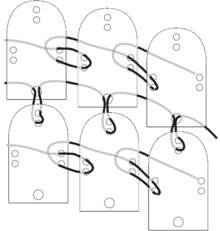Lamellar armor
As a slatted armor is called an armor consisting of numerous interconnected metal plates or metal strips.
description
In contrast to the scale armor or the fountain , the metal plates were not attached to a solid base, but loosely linked. The individual panels were mostly roughly rectangular in shape and tied together with threads. The plates could partially overlap. The lamellar armor emerged from the scale armor and, like it, is one of the oldest types of armor made of metal in human history. The Chinese were probably the first to use lamellar armor. The oldest preserved Chinese lamellar armor dates from the 14th century BC. And protected the entire hull. In the early Middle Ages , the Japanese also took over the lamellar armor from the Chinese, usually held together with leather straps, and developed their own shapes from them. The Assyrians also made use of this type of armor. The metal sheets used for the short-sleeved tanks of the Assyrians were initially made of bronze , but since the 10th century BC. Chr. Were iron sheets used. Since the 8th century BC The Assyrians wore lamellar armor that went down to their ankles. The next people in the Ukraine were the Northern Iranian Scythians to make extensive use of lamellar armor. It is believed that the Scythians adopted this technique from the Assyrians during their early campaigns in Asia Minor and Mesopotamia .
Such armaments were also used by the Etruscans and Romans , but they were replaced by the in the 2nd century BC. Chr. Emerging Chain Armor displaced. The greatest advantage of the lamellar armor was its flexibility, but it was surpassed by the chain armor. In addition, a stabbing weapon could not penetrate the dense network of iron rings as easily as an impact that got directly between two sheets of lamellar armor. Scale and chain armor had been the most important metal armor in Europe since late antiquity , until they were replaced by full plate armor in the late Middle Ages . However, the lamellar armor was increasingly used again between 950 and 1350 in Eastern Europe and Byzantium , and the special form of the Klibanion prevailed in the Byzantine military . After that, the lamellar armor was only used in significant numbers in Asia and the Orient , as it was a suitable armor with its relatively low weight and weak heat development in the local climatic conditions. In the Orient, the use of this type of armor can be traced back to the 16th century.
Lamellar armor was particularly popular throughout the Middle Ages with the Eurasian cavalry peoples ( Huns , Avars , Pechenegs , Polovetser ) and in Mongolian warfare . They also made helmets out of lamellas ( lamellar helmets ), which also found their way into the Alamann prince graves via the Avars (grave of Niederstotzingen ).
literature
- Klaus Becker and Holger Riesch: Investigations into metallurgy and efficiency of Merovingian lamellar armor. In: Archaeological correspondence sheet: Prehistory, Roman times, early Middle Ages. Year 32/2002, Verlag des Römisch-Germanisches Zentralmuseum Mainz, Mainz 2002, p. 597 ff.


